
Aug 28
/
Pedro Schicchi
Grains, Oilseeds and Livestock Weekly Report - 2023 08 28
Back to main blog page
"Brazilian farmers face decisions on what and how much to plant, with tighter margins for winter corn soybeans when compared to the last few years. The influence of El Niño on crop yields varies by region, with potentially positive effects on Southern states and slightly negative impacts on Central and Northern states.
With mild acreage growth and a positive yield outlook, we project soybean production at around 163 million tons. Corn production prospects are less favorable due to economic factors and less optimism regarding yield, with total production estimated at 133M ton, similar to our current estimate for 22/23 despite some acreage growth."
New crop estimates for Brazil (23/24)
Brazilian farmers have been deciding on what and, more importantly, how much to plant. The “what” is usually an easier question to answer, since in most of Brazil it is possible to plant corn as the second crop, and soybeans are preferred for the summer. “How much” is the real question.
This year we have lower costs, but also lower prices. However, grain prices have fallen more than inputs and, as such, margins are tighter than they were in the last three years. While this is true for both, expected margins for winter corn are tighter than those of beans.
Two points stem from this fact. One is that tighter margins require more attention to risk management, as market movements can erode profits more easily. Two is that we should expect less area growth from what we have been seeing in the last few years.
Image 1: Brazil Soybean – Gross Return Expected in July (BRL/ha)
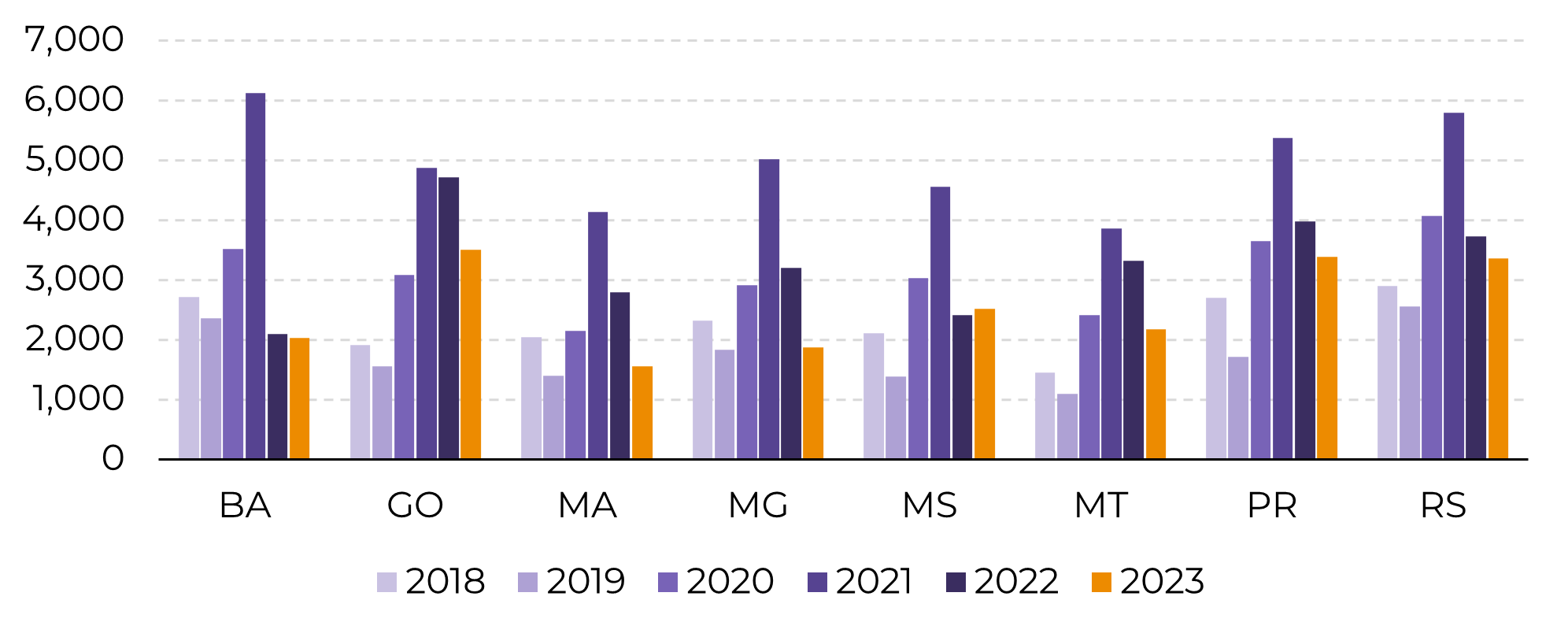
Source: Conab, hEDGEpoint. Includes only operational costs
Image 2: Brazil Winter Corn – Gross Return Expected in July (BRL/ha)
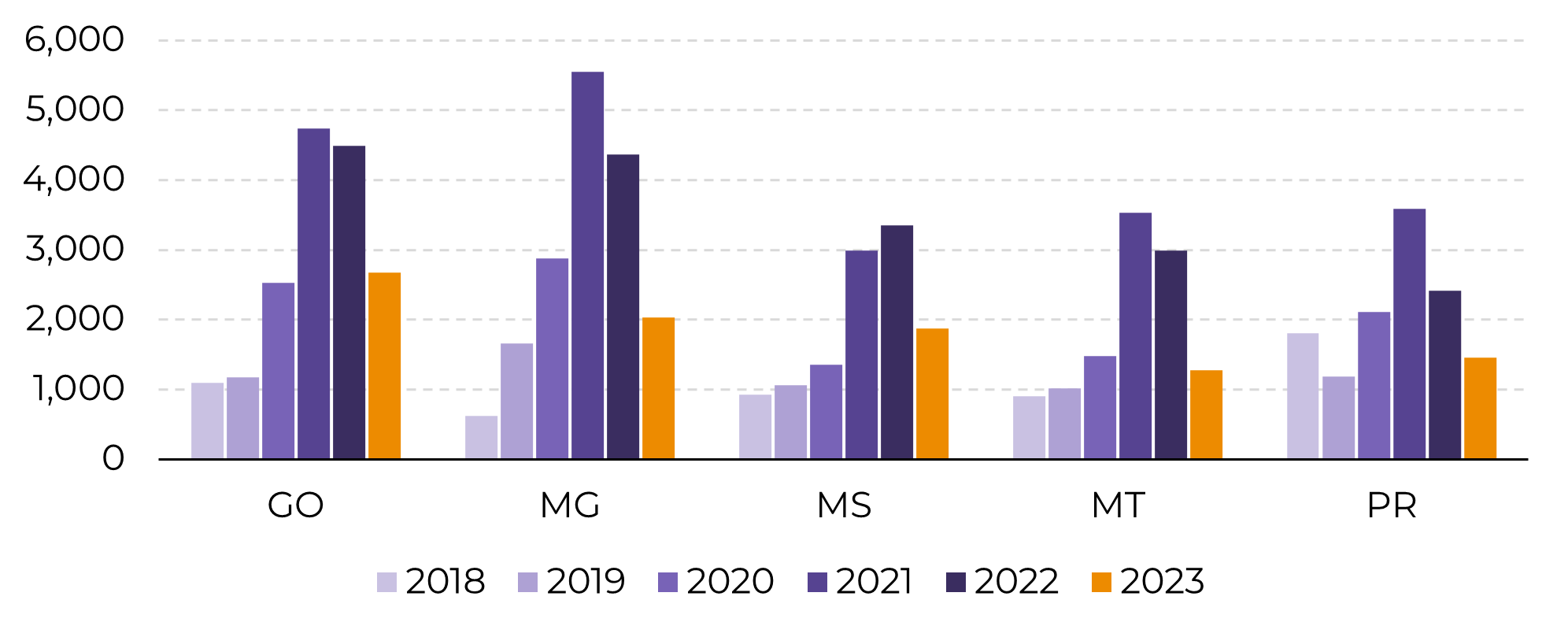
Source: Conab, hEDGEpoint. Includes only operational costs
Margins affect the area, but what can we say about yields?
Since yields are hard to predict even as the crop is developing, you can imagine how accurate pre-crop estimates are. Still, we have an El Niño year ahead of us.
However, that’s not always the case, as El Niño is not really correlated to precipitation in the North. Still. Rio Grande do Sul and Paraná combined usually produce about 40M ton of soybeans in regular years, and MATOPIBA amounted to ~20M ton in 22/23. As such, the good prospects for the South have more impact on Brazil’s final number.
Thus, the losses in the Center and Northern states could be bigger, while the state that’s the biggest beneficiary of the phenomenon is not in the equation to offset this effect.
We had a whole report discussing the effects of the phenomenon on crops. The gist of it is that in the Brazilian summer, El Niño tends to be positive to Southern states as it brings good rainfall levels – the opposite of what has been going on in these last couple of La Niña years.
Conversely, it tends to be slightly negative to Center-Northern states as it brings slightly above-average temperatures, which, if combined with low precipitation, can lead to losses.
However, that’s not always the case, as El Niño is not really correlated to precipitation in the North. Still. Rio Grande do Sul and Paraná combined usually produce about 40M ton of soybeans in regular years, and MATOPIBA amounted to ~20M ton in 22/23. As such, the good prospects for the South have more impact on Brazil’s final number.
As for winter corn, the scenario is not exactly the same. The general trends remain: positive to the South and negative to the North. However, corn is more sensitive to high temperatures than beans, and, additionally, Rio Grande do Sul does not produce winter corn.
Thus, the losses in the Center and Northern states could be bigger, while the state that’s the biggest beneficiary of the phenomenon is not in the equation to offset this effect.
Image 3a: Temp. Anomaly on El Niño Years – Dec (std devs from normal)
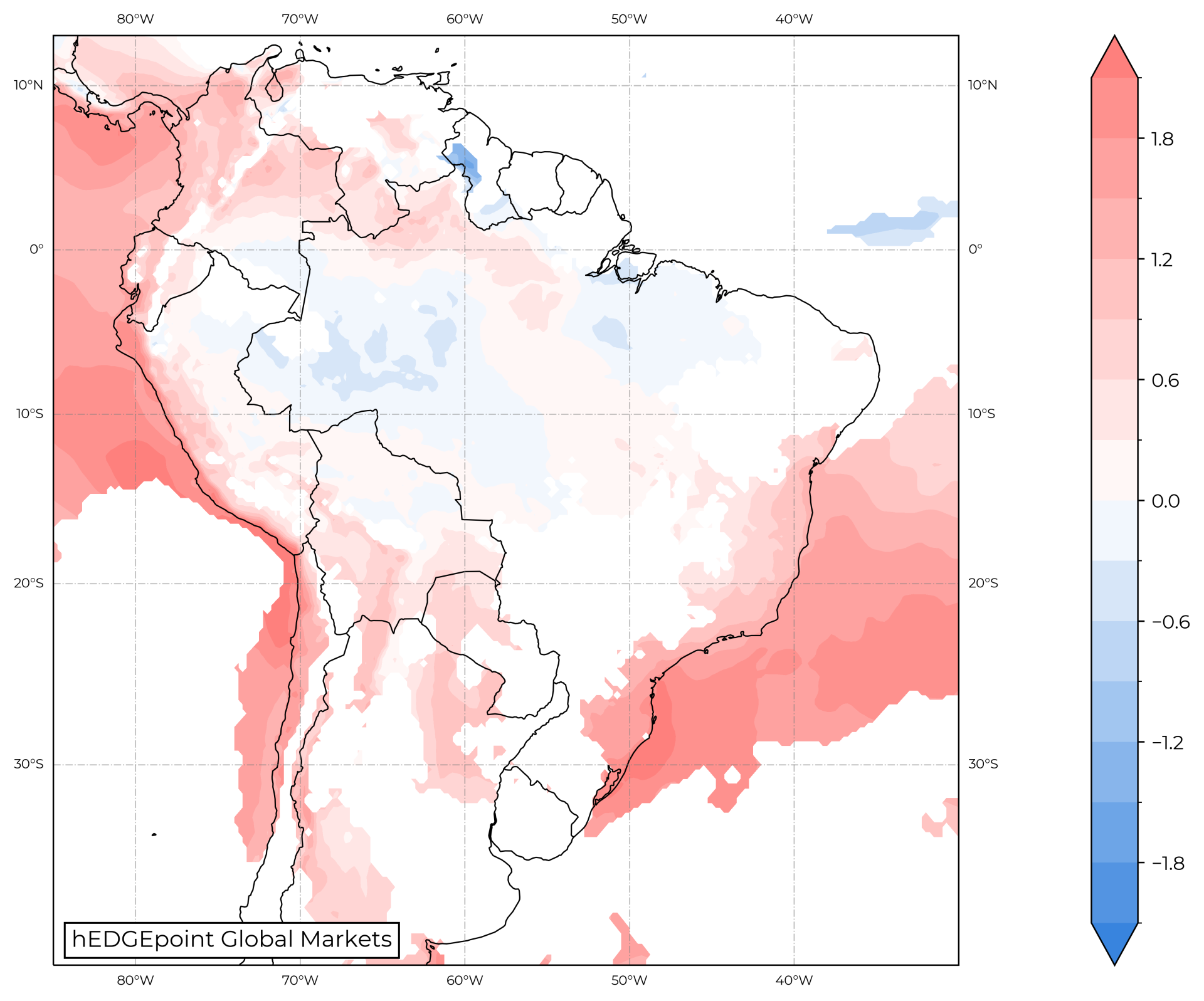
Source: NOAA, hEDGEpoint
Image 3b: Precip. Anomaly on El Niño Years – Dec (std devs from normal)
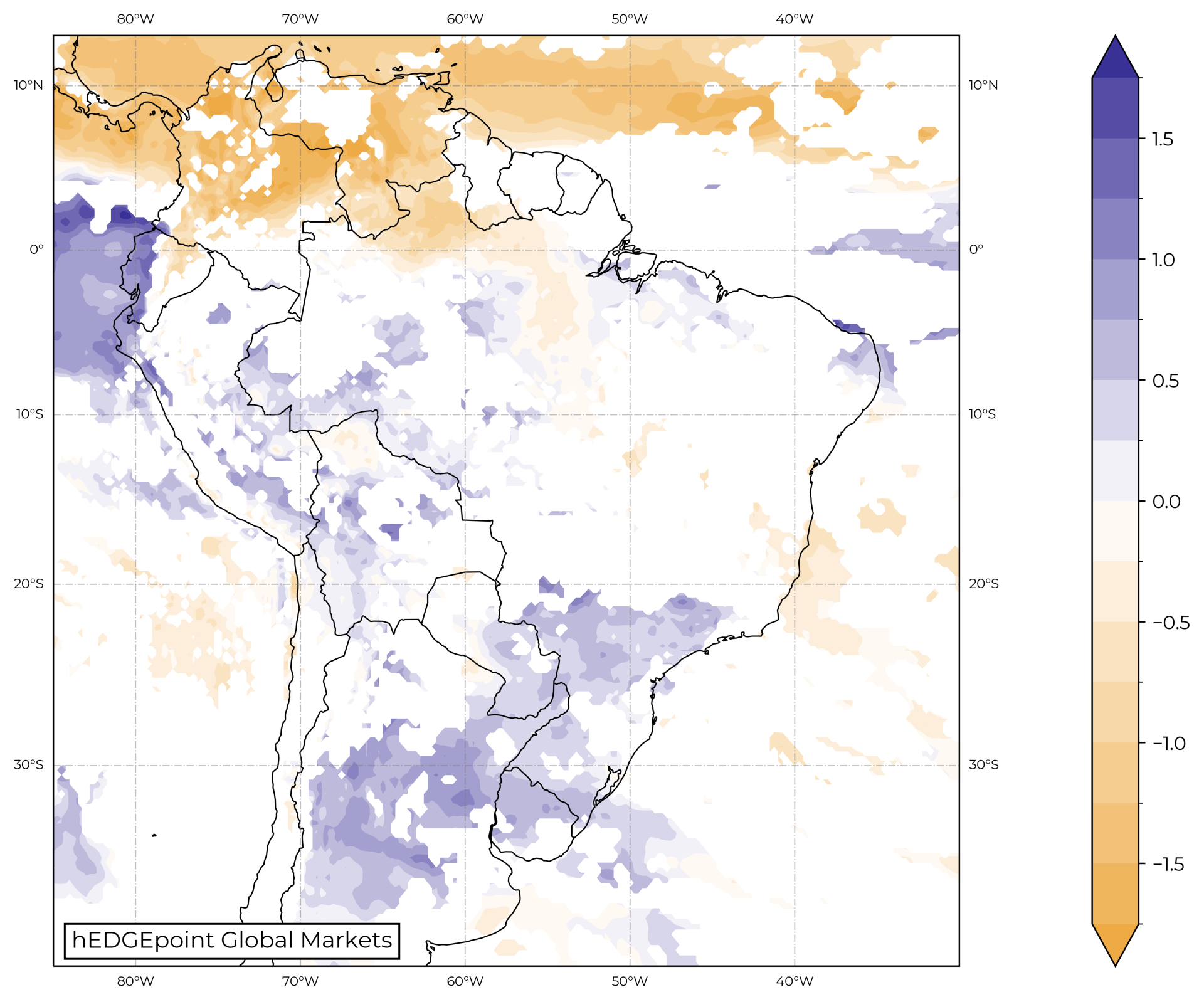
Source: NOAA, hEDGEpoint
Image 4: Correlation between State Yields and the Strength of El Niño
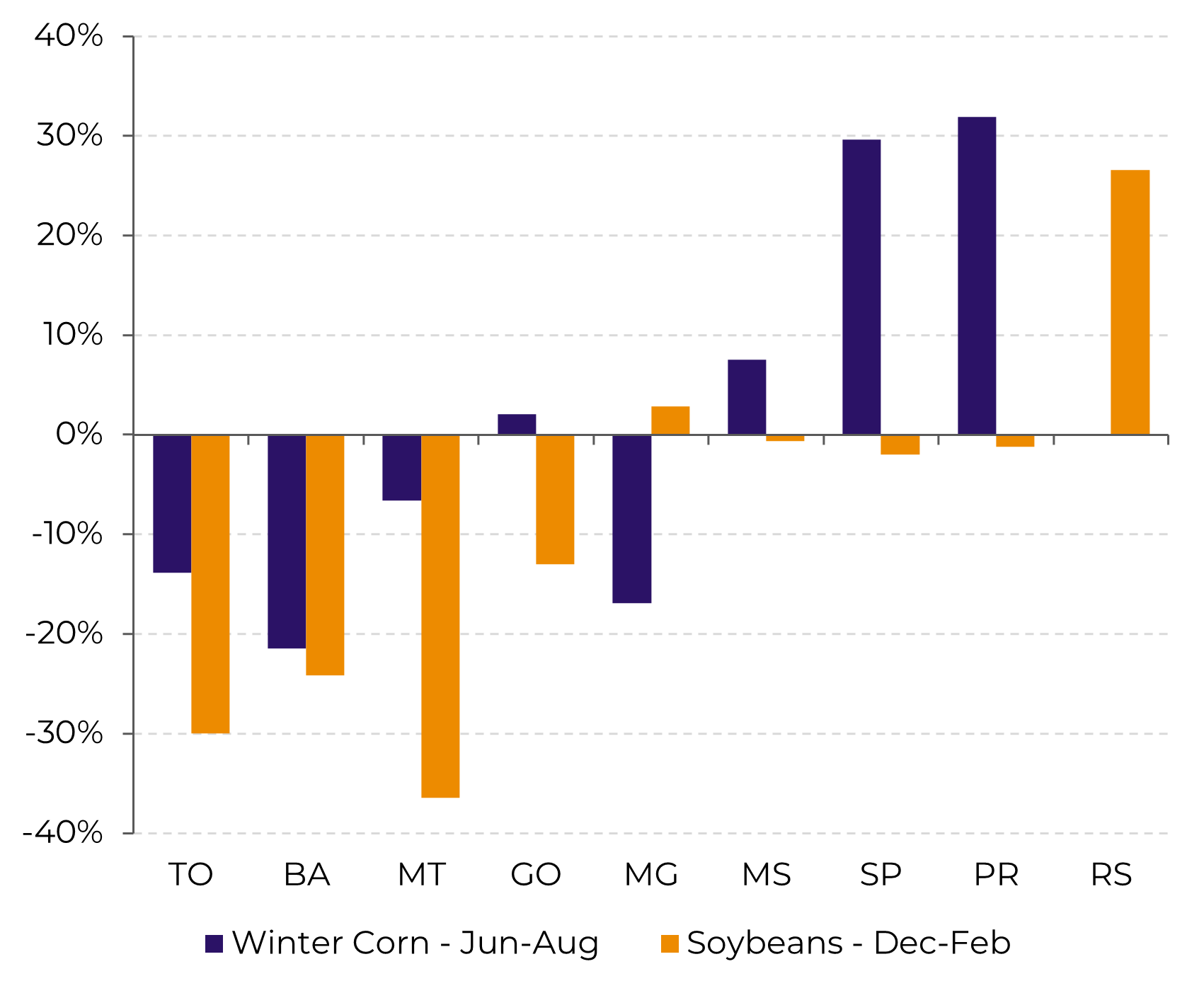
Source: hEDGEpoint
Finally, the production estimates
Piecing it all together. On soybeans, we have acreage growth, though not as high as in previous years, and a mild to positive outlook for yields. In turn, this gives us the projection presented in Figure 5.
Switching to corn, this year has already been economically bad for producers of the grain. Coupling this with what is supposed to be a good crop out of the US, the incentive to plant corn in Brazil is smaller than to plant beans, though this is debatable. In turn, the acreage growth we expect is also smaller.
We estimate production at around 163M ton, but that could easily be increased if we have good yields in Center-West and MATOPIBA, as Rio Grande do Sul alone is likely to recover from this year’s 15M ton to more than 20M ton on good rainfall.
Switching to corn, this year has already been economically bad for producers of the grain. Coupling this with what is supposed to be a good crop out of the US, the incentive to plant corn in Brazil is smaller than to plant beans, though this is debatable. In turn, the acreage growth we expect is also smaller.
Additionally, we don’t have as good of an outlook for yields and 22/23 yields were spectacular against all odds. As such, we estimate production at around the same levels as in 22/23, even with area growth, as this year’s results might not repeat themselves.
Image 5: Brazil Soybeans – Area, Yield and Production (M ha, ton/ha, M ton)
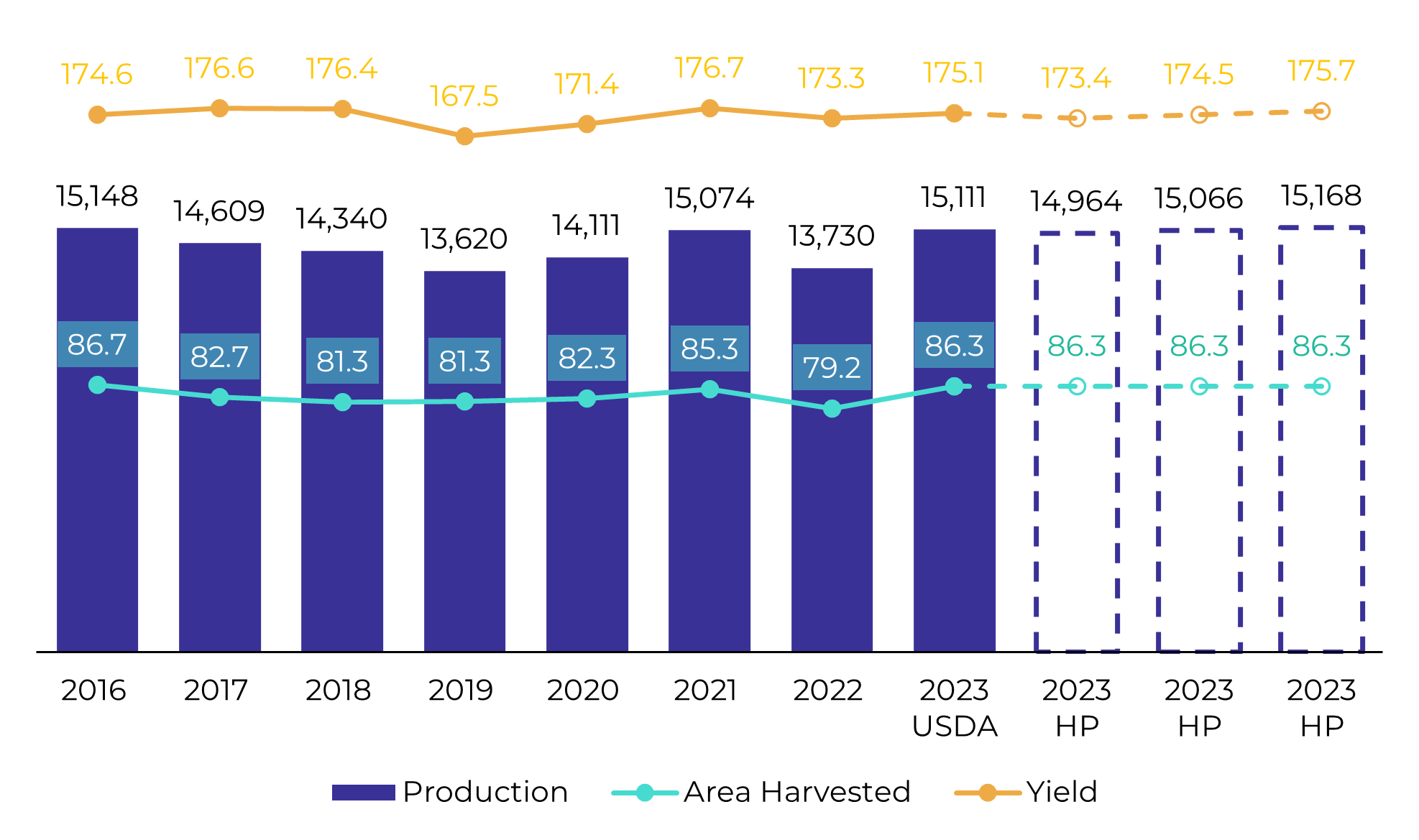
Source: USDA, Hedgepoint
Image 6: Brazil Corn – Area, Yield and Production (M ha, ton/ha, M ton)
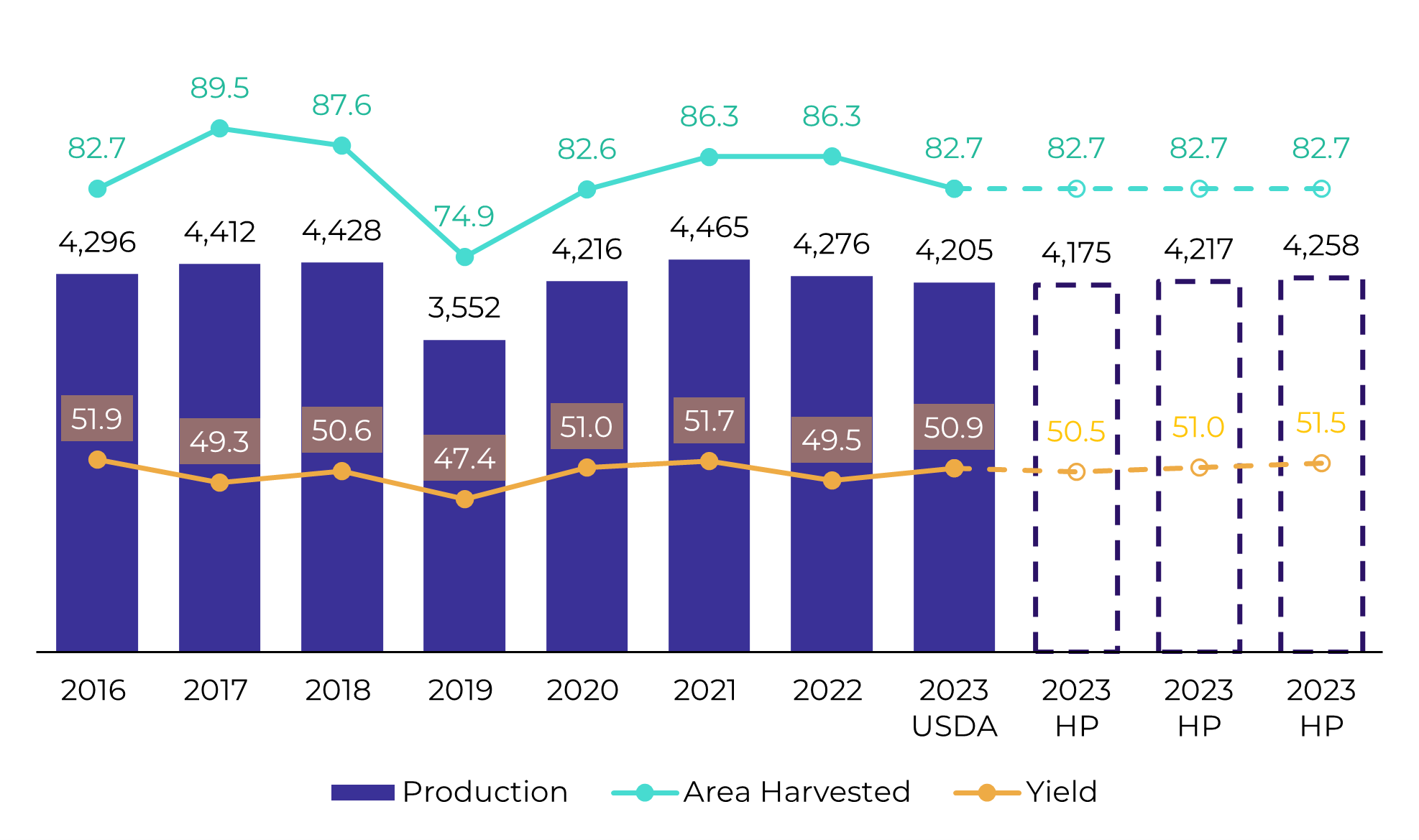
Source: USDA, Hedgepoint
Weekly Report — Grains and Oilseeds
Written by Pedro Schicchi
pedro.schicchi@hedgepointglobal.com
pedro.schicchi@hedgepointglobal.com
Reviewed by Natália Gandolphi
natalia.gandolphi@hedgepointglobal.com
natalia.gandolphi@hedgepointglobal.com
www.hedgepointglobal.com
Disclaimer
This document has been prepared by hEDGEpoint Global Markets LLC and its affiliates ("HPGM") exclusively for informational and instructional purposes, without the purpose of creating obligations or commitments with third parties, and is not intended to promote an offer, or solicitation of an offer, to sell or buy any securities or investment products. HPGM and its associates expressly disclaim any use of the information contained herein that may result in direct or indirect damage of any kind. If you have any questions that are not resolved in the first instance of contact with the client (client.services@hedgepointglobal.com), please contact our internal ombudsman channel (ouvidoria@hedgepointglobal.com) or 0800-878-8408 (for clients in Brazil only).
Contact us
hedgepointhub.support@hedgepointglobal.com
ouvidoria@hedgepointglobal.com
Funchal Street, 418, 18º floor - Vila Olímpia São Paulo, SP, Brasil
Check our general terms and important notices.
This page has been prepared by Hedgepoint Schweiz AG and its affiliates (“Hedgepoint”) solely for informational and instructional purposes, without the purpose of instituting obligations or commitments to third parties, nor is it intended to promote an offer, or solicitation of an offer of sale or purchase relating to any securities, commodities interests or investment products. Hedgepoint and its associates expressly disclaim any use of the information contained herein that directly or indirectly result in damages or damages of any kind. Information is obtained from sources which we believe to be reliable, but we do not warrant or guarantee the timeliness or accuracy of this information. The trading of commodities interests such as futures, options, and swaps involves substantial risk of loss and may not be suitable for all investors. You should carefully consider wither such trading is suitable for you in light of your financial condition. Past performance is not necessarily indicative of future results. Customers should rely on their own independent judgement and/or advisors before entering in any transaction.Hedgepoint does not provide legal, tax or accounting advice and you are responsible for seeking any such advice separately.Hedgepoint Schweiz AG is organized, incorporated, and existing under the laws of Switzerland, is filiated to ARIF, the Association Romande des Intermédiaires Financiers, which is a FINMA-authorized Self-Regulatory Organization. Hedgepoint Commodities LLC is organized, incorporated, and existing under the laws of the USA, and is authorized and regulated by the Commodity Futures Trading Commission (CFTC) and a member of the National Futures Association (NFA) to act as an Introducing Broker and Commodity Trading Advisor. HedgePoint Global Markets Limited is Regulated by the Dubai Financial Services Authority. The content is directed at Professional Clients and not Retail Clients. Hedgepoint Global Markets PTE. Ltd is organized, incorporated, and existing under the laws of Singapore, exempted from obtaining a financial services license as per the Second Schedule of the Securities and Futures (Licensing and Conduct of Business) Act, by the Monetary Authority of Singapore (MAS). Hedgepoint Global Markets DTVM Ltda. is authorized and regulated in Brazil by the Central Bank of Brazil (BCB) and the Brazilian Securities Commission (CVM). Hedgepoint Serviços Ltda. is organized, incorporated, and existing under the laws of Brazil. Hedgepoint Global Markets S.A. is organized, incorporated, and existing under the laws of Uruguay. In case of questions not resolved by the first instance of customer contact (client.services@Hedgepointglobal.com), please contact internal ombudsman channel (ombudsman@hedgepointglobal.com – global or ouvidoria@hedgepointglobal.com – Brazil only) or call 0800-8788408 (Brazil only).Integrity, ethics, and transparency are values that guide our culture. To further strengthen our practices, Hedgepoint has a whistleblower channel for employees and third-parties by e-mail ethicline@hedgepointglobal.com or forms Ethic Line – Hedgepoint Global Markets.Security note: All contacts with customers and partners are conducted exclusively through our domain @hedgepointglobal.com. Do not accept any information, bills, statements or requests from different domains and pay special attention to any variations in letters or spelling, as they may indicate a fraudulent situation.“HedgePoint” and the “HedgePoint” logo are marks for the exclusive use of HedgePoint and/or its affiliates. Use or reproduction is prohibited, unless expressly authorized by HedgePoint. Furthermore, the use of any other marks in this document has been authorized for identification purposes only. It does not, therefore, imply any rights of HedgePoint in these marks or imply endorsement, association or seal by the owners of these marks with HedgePoint or its affiliates.
We have updated our Terms & Conditions to reflect improvements to our platform, data handling practices, and the overall experience we provide to our clients.
To continue using the Hedgepoint HUB, please review and accept the updated terms.

